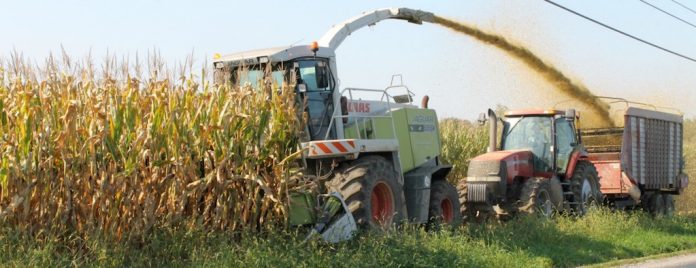By Chris Zoller and Jason Hartschuh
Corn silage is a critical ingredient in rations fed to dairy cattle, and in just a few weeks, the harvesting process will begin.
Making high-quality corn silage is time sensitive and breakdowns can be costly. A breakdown in the field can lead to delayed harvest and lower-quality silage, resulting in poor milk production and animal performance. Now is the time to be reviewing, servicing and preparing equipment used in the silage harvest process so that downtime doesn’t decrease your silage quality.
Inspection
All parts of your forage harvester must be inspected from front to back. The machine was likely cleaned at the end of the last harvest. If not, now is the time to give it a thorough cleaning. Check the condition and tension of belts. Are there any that are worn, loose, or cracked? If so, adjust the tension or replace with new ones. Refer to the owner’s manual for areas to lubricate. If an auto lube system is on the machine, check each line and bearing that is lubricated to be sure it is working properly. Did rodents damage any wiring over the winter storage period? If so, make necessary repairs. While going over the machine, attempt to wiggle any shaft at the bearing. Once belts and bearings are inspected and lubrication is complete, run the machine at a low speed to check moving parts, gauges and listen for anything that doesn’t sound correct – slipping belts, worn bearings, etc.
Check engine oil, brake fluid, gearboxes and any other fluids. Are there seals or hoses that are cracked, leaking and in need of replacement? If safety shields and guards were removed for some reason, make sure they’re replaced to provide protection from injury or death. Check the fire extinguisher to be sure it’s still functional. Machines should carry two fire extinguishers, one that is an ABC dry chemical and another that is a water cannon with a foaming agent. Check lights, back-up beepers and condition of the slow-moving vehicle (SMV) emblem. Clean and/or replace any of these items that need attention.
Be sure to inspect wear parts and consider if they have enough hard surface left for the season. For knives, the minimum is 3 mm. Adjusting the cutter bar and knives prior to corn silage harvest so that the cutter bar has its full adjustment range can save on in-season hassles. Checking knife torque prior to harvest is also recommended so that no knives come loose during harvest, causing costly internal damage to the machine. On the corn head, inspect the cleaners so that weeds don’t wrap around the header.
Kernel processor operation is critical to making high-quality corn silage. While the true inspection of kernel processing score comes during harvest, each time you change hybrids, a proper inspection will keep the processor working through the season.
Roll spacing, tooth sharpness and springs should be inspected. Springs can weaken over time and develop cracks that lead to critical failure in-season. The roll gap should be between 2 to 3 mm depending on the processor design. A nickel is 1.95 mm thick and older processors should leave marks in the nickel. While newer, more aggressive systems should brush a dime off, a nickel/dime stack or feeler gauges can be used to check if rolls are the proper gap. Check multiple areas across the rolls for wear.
The in-season inspection of kernel processors is done with a water separation or visual inspection of a 1-quart sample of silage. Both methods look for the number of whole kernels, with a criterion that no more than one whole kernel is present in the sample. The water method uses a 5-gallon bucket to float most of the fodder off the sample to make kernel separation easier. Once fodder is removed, sort kernels looking for any that are not nicked by the processor.
Checking other equipment
Besides the harvester, thoroughly inspect and service all other equipment used for harvest, as each plays a critical role in keeping harvest on time. For equipment running on the road, determine whether all brakes, lights and mirrors are in working order. Lastly, before pulling a silage wagon or trailer on the road, ask yourself if the truck or tractor can, if necessary, stop the load quickly. Just because a machine can move a load does not mean it should.
Moisture
Harvesting silage at the proper moisture is critical. Corn preserved between 30% and 38% dry matter (62% to 70% moisture) generally provides excellent silage fermentation and animal performance. The type of structure in which the silage will be stored dictates the ideal moisture.
(Chris Zoller is an agricultural extension educator and county Extension director in Tuscarawas County, and a member of the OSU Extension DairyExcel team. Questions or comments can be sent in care of Farm and Dairy, P.O. Box 38, Salem, OH 44460. Jason Hartschuh is an assistant professor and field specialist in dairy management and precision livestock at Ohio State University Extension. He can be reached at hartschuh.11@osu.edu.)













